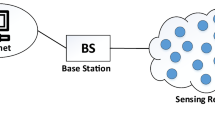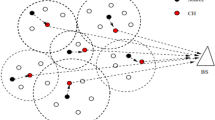Abstract
Wireless sensor networks (WSNs) offer a multitude of advantages and find applications across various domains, garnering substantial research interest. However, a notable drawback in these networks is the energy consumption, which can be mitigated through compression techniques. Additionally, the limited lifespan of sensor batteries remains a concern. Even when incorporating renewable energy sources, ensuring energy efficiency in WSNs is imperative. One prevailing issue is the disregard for spatial data correlation in existing data clustering methods within WSNs. Addressing these challenges necessitates effective modeling and the acquisition of event source locations in the proposed scheme. In this work, we propose an energy-efficient lifetime-aware cluster based routing (EELCR) for WSN. In EELCR technique, modified giant trevally optimization (MGTO) algorithm is introduced for efficient balanced clustering which minimizes energy consumption. An optimal squirrel search (OSS) algorithm is used to selects the best optimal node, named as cluster head (CH) for prolonging the lifetime in the sensor networks. Each CH nodes compress clustering data using optimal selective Huffman compression to achieve maximum compression ratio which overcomes inefficiency of area overhead problem in existing Huffman compression. Furthermore, we develop a hybrid deep learning technique which combines deep neural network (DNN) with Granular neural network (GNN) (named as DGNN) to find optimal way for data broadcast from CH to base station (BS). Finally, we assess the efficacy of the proposed EELCR approach through various simulation scenarios, demonstrating its effectiveness concerning Quality of Service (QoS) parameters. The outcomes reveal a notable enhancement in our coding scheme, with an average compression rate improvement of 9.346% when compared to state-of-the-art coding techniques. Furthermore, our proposed EELCR technique significantly outperforms existing routing methods, exhibiting an average network lifetime improvement of 51.88% in node density considerations and 52.625% in simulation rounds, respectively.












Similar content being viewed by others
References
Mao, W., Zhao, Z., Chang, Z., Min, G., & Gao, W. (2021). Energy-efficient industrial internet of things: Overview and open issues. IEEE Transactions on Industrial Informatics, 17(11), 7225–7237.
Li, F., Lam, K. Y., Li, X., Sheng, Z., Hua, J., & Wang, L. (2019). Advances and emerging challenges in cognitive internet-of-things. IEEE Transactions on Industrial Informatics, 16(8), 5489–5496.
Yao, Y., Cao, Q., & Vasilakos, A. V. (2014). EDAL: An energy-efficient, delay-aware, and lifetime-balancing data collection protocol for heterogeneous wireless sensor networks. IEEE/ACM Transactions on Networking, 23(3), 810–823.
Xiao, M., Wu, J., & Huang, L. (2014). Time-sensitive utility-based single-copy routing in low-duty-cycle wireless sensor networks. IEEE Transactions on Parallel and Distributed Systems, 26(5), 1452–1465.
Cota-Ruiz, J., Rivas-Perea, P., Sifuentes, E., & Gonzalez-Landaeta, R. (2016). A recursive shortest path routing algorithm with application for wireless sensor network localization. IEEE Sensors Journal, 16(11), 4631–4637.
Brar, G. S., Rani, S., Chopra, V., Malhotra, R., Song, H., & Ahmed, S. H. (2016). Energy efficient direction-based PDORP routing protocol for WSN. IEEE Access, 4, 3182–3194.
Huynh, T. T., Dinh-Duc, A. V., & Tran, C. H. (2016). Delay-constrained energy-efficient cluster-based multi-hop routing in wireless sensor networks. Journal of Communications and Networks, 18(4), 580–588.
Sasirekha, S., & Swamynathan, S. (2017). Cluster-chain mobile agent routing algorithm for efficient data aggregation in wireless sensor network. Journal of Communications and Networks, 19(4), 392–401.
Bhavathankar, P., Chatterjee, S., & Misra, S. (2017). Link-quality aware path selection in the presence of proactive jamming in fallible wireless sensor networks. IEEE Transactions on Communications, 66(4), 1689–1704.
Saleem, F., Majeed, M. N., Iqbal, J., Waheed, A., Rauf, A., Zareei, M., & Mohamed, E. M. (2021). Ant lion optimizer based clustering algorithm for wireless body area networks in livestock industry. IEEE Access, 9, 114495–114513.
Yang, L., Lu, Y., Yang, S. X., Guo, T., & Liang, Z. (2020). A secure clustering protocol with fuzzy trust evaluation and outlier detection for industrial wireless sensor networks. IEEE Transactions on Industrial Informatics, 17(7), 4837–4847.
Zheng, J., Wang, P., & Li, C. (2010). Distributed data aggregation using Slepian-Wolf coding in cluster-based wireless sensor networks. IEEE Transactions on Vehicular Technology, 59(5), 2564–2574.
Paek, J., & Ko, J. (2015). $ K $-Means clustering-based data compression scheme for wireless imaging sensor networks. IEEE Systems Journal, 11(4), 2652–2662.
Arunraja, M., Malathi, V., & Sakthivel, E. (2015). Distributed similarity based clustering and compressed forwarding for wireless sensor networks. ISA Transactions, 59, 180–192.
Lan, K. C., & Wei, M. Z. (2017). A compressibility-based clustering algorithm for hierarchical compressive data gathering. IEEE Sensors Journal, 17(8), 2550–2562.
Wei, Z., Lijuan, S., Jian, G., & Linfeng, L. (2016). Image compression scheme based on PCA for wireless multimedia sensor networks. The Journal of China Universities of Posts and Telecommunications, 23(1), 22–30.
Chen, S., Liu, J., Wang, K., & Wu, M. (2019). A hierarchical adaptive spatio-temporal data compression scheme for wireless sensor networks. Wireless Networks, 25(1), 429–438.
Uthayakumar, J., Vengattaraman, T., & Dhavachelvan, P. (2019). A new lossless neighborhood indexing sequence (NIS) algorithm for data compression in wireless sensor networks. Ad Hoc Networks, 83, 149–157.
Pacharaney, U. S., & Gupta, R. K. (2019). Clustering and compressive data gathering in wireless sensor network. Wireless Personal Communications, 109(2), 1311–1331.
Chen, S., Zhang, S., Zheng, X., & Ruan, X. (2019). Layered adaptive compression design for efficient data collection in industrial wireless sensor networks. Journal of Network and Computer Applications, 129, 37–45.
Sheeja, R., & Sutha, J. (2020). Soft fuzzy computing to medical image compression in wireless sensor network-based tele medicine system. Multimedia Tools and Applications, 79(15), 10215–10232.
Ghaderi, M. R., TabatabaVakili, V., & Sheikhan, M. (2020). FGAF-CDG: Fuzzy geographic routing protocol based on compressive data gathering in wireless sensor networks. Journal of Ambient Intelligence and Humanized Computing, 11(6), 2567–2589.
Singh, A., & Nagaraju, A. (2020). Low latency and energy efficient routing-aware network coding-based data transmission in multi-hop and multi-sink WSN. Ad Hoc Networks, 107, 102182.
Rani, M. J., & Vasanthanayaki, C. (2020). Network condition based multi-level image compression and transmission in WSN. Computer Communications, 150, 317–324.
Aziz, A., Osamy, W., Khedr, A. M., El-Sawy, A. A., & Singh, K. (2020). Grey Wolf based compressive sensing scheme for data gathering in IoT based heterogeneous WSNs. Wireless Networks, 26(5), 3395–3418.
Reddy, V., & Gayathri, P. (2020). Energy efficient data transmission in WSN thru compressive slender penetrative etiquette. Journal of Ambient Intelligence and Humanized Computing, 11(11), 4681–4693.
Aziz, A., Singh, K., Osamy, W., & Khedr, A. M. (2020). An efficient compressive sensing routing scheme for internet of things based wireless sensor networks. Wireless Personal Communications, 114(3), 1905–1925.
Ghaderi, M. R., TabatabaVakili, V., & Sheikhan, M. (2021). Compressive sensing-based energy consumption model for data gathering techniques in wireless sensor networks. Telecommunication Systems, 77(1), 83–108.
Jari, A., & Avokh, A. (2021). PSO-based sink placement and load-balanced anycast routing in multi-sink WSNs considering compressive sensing theory. Engineering Applications of Artificial Intelligence, 100, 104164.
Molk, A.M.N.G., Ghoreishi, S.M., Ghasemi, F. and Elyasi, I. (2022). Improve performances of wireless sensor networks for data transfer based on fuzzy clustering and huffman compression. Journal of Sensors.
Mishra, M., Sen Gupta, G., & Gui, X. (2022). Investigation of energy cost of data compression algorithms in WSN for IoT applications. Sensors, 22(19), 7685.
Funding
No financial support was provided by any funding agency.
Author information
Authors and Affiliations
Contributions
All authors equally contributed in the manuscript
Corresponding author
Ethics declarations
Conflict of interest
The authors declare that they have no known competing financial interests or personal relationships that could have appeared to influence the work reported in this paper.
Additional information
Publisher's Note
Springer Nature remains neutral with regard to jurisdictional claims in published maps and institutional affiliations.
Rights and permissions
Springer Nature or its licensor (e.g. a society or other partner) holds exclusive rights to this article under a publishing agreement with the author(s) or other rightsholder(s); author self-archiving of the accepted manuscript version of this article is solely governed by the terms of such publishing agreement and applicable law.
About this article
Cite this article
Sulthana, N.N., Duraipandian, M. EELCR: energy efficient lifetime aware cluster based routing technique for wireless sensor networks using optimal clustering and compression. Telecommun Syst 85, 103–124 (2024). https://doi.org/10.1007/s11235-023-01068-4
Accepted:
Published:
Issue Date:
DOI: https://doi.org/10.1007/s11235-023-01068-4




